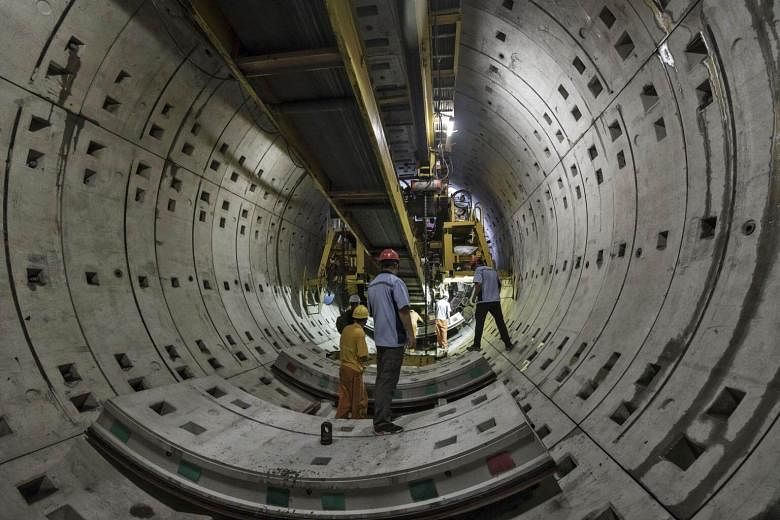BEIJING (BLOOMBERG) - China's frenzied construction of subway systems in cities all over the country may be easing, amid reports funding has been pulled for some projects as Beijing pushes to rein in debt levels.
The National Development and Reform Commission, China's top economic planning body, is revising a 2003 policy on subway development, Caixin reported on Saturday (Nov 18).
The NDRC wants to "raise the bar" for approving local rail projects amid growing concern over a debt-driven infrastructure boom, the financial magazine said, citing sources that it did not identify.
Population levels, as well as the economy and fiscal conditions of Chinese cities seeking permission for subway projects will be more closely scrutinised, Caixin said. The NDRC did not immediately reply to questions faxed on Saturday by Bloomberg News.
Subway construction is a constant presence in China's cities, with streets torn up to build the capacity needed to transport the swelling ranks of urban commuters. Beijing alone has been testing three lines: a driverless subway, a maglev train, and a tram to be launched in the city's western suburbs at the end of the year, the official Xinhua News Agency reported in September. But investment in the sector appears to be tapering off, just as China's leaders make reining in financial risks a top priority.
Fixed-asset investment in rail transportation has slowed almost to a standstill in 2017, increasing just 0.4 per cent in January-October from a year earlier, statistics bureau data show. That is down from 3.5 per cent growth in the first four months of the year. Private rail transport investment - which makes up a tiny share of an industry that is dominated by state-backed enterprises - slumped 58.6 per cent January-October from a year earlier.
Cities in Inner Mongolia have been told by China's central government to halt infrastructure projects, Caixin reported earlier this month. That included a 30 billion-yuan (S$6 billion) subway project in the city of Baotou, and another valued at 27 billion yuan in the regional capital, Hohhot.
Bloomberg's calls to the media office of Hohhot's city government were not answered after regular business hours, and a hotline for the mayor of Baotou also was not picked up on Saturday.
Reduced rail investment would be a reversal for a country that has feverishly embraced trains. China operated nearly 2,600 high-speed trains at the end of 2016, 60 per cent of the total worldwide, according to Xinhua. The fast-rail network has surpassed 20,000km and leaders are targeting 45,000km by 2030, the state-media service said in June.
In 2012, the NDRC approved plans for subways in 18 Chinese cities including southern export powerhouses Guangzhou and Shenzhen. Back then, the body also authorised inter-city rail projects throughout Inner Mongolia, Gansu, Ningxia and Jiangsu province.
DEBT BUBBLE
Still, Yicai Global, a state-backed business publication, reported in September that some 43 so-called third-tier cities - mostly in provinces in China's more populous east - secured approval to build subways as part of economic development and urbanisation efforts.
Inner Mongolia's population has held at around 25 million since 2010, according to the northern region's statistics bureau, while the eastern province of Zhejiang, the headquarters of e-retailing giant Alibaba Group, is home to almost double that many people.
If China is taking a more discriminating approach to infrastructure growth, it marks an about turn. In the wake of the global financial crisis, the government championed projects in far flung provinces - from new highways to sports stadiums - as a way of keeping people employed and maintaining economic momentum. That spending saw leverage balloon to more than double gross domestic product, a risk factor Beijing is now trying to tackle.
People's Bank of China Governor Zhou Xiaochuan has issued blunt warnings about debt levels in the world's second-largest economy. Regulators have been clamping down on shadow banking and trying to deter bond issuance.
In October, Zhou called for further measures to constrain local government borrowing. The liabilities built up by local authorities' financing vehicles in the post-crisis spending binge became symbolic for many investors of China's excesses when it comes to debt.
Both Moody's Investors Service and S&P Global Ratings have reduced China's credit rating this year citing risks from extreme leverage, while the International Monetary Fund warned in June that deep reforms will be needed to break away from debt-fuelled growth.

